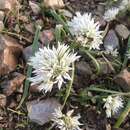Description
provided by eFloras
Bulbs 1–5, not clustered on stout, primary rhizome, ovoid to globose, 0.7–1.5 × 0.6–1.4 cm; outer coats enclosing 1 or more bulbs, brown to grayish brown, membranous, usually distinctly cellular-reticulate, cells isodiametric or ± narrowly hexagonal, transversely elongate, without fibers; inner coats red to purple or white, cells obscure, quadrate to ± transversely elongate. Leaves usually persistent, green at anthesis, 2, basally sheathing, sheaths not extending much above soil surface; blade solid, flat or channeled, ± falcate, 8–27 cm × 1–3 mm, margins entire. Scape persistent, solitary, erect, solid, terete, 3–10(–20) cm × 1–3 mm. Umbel persistent, erect, compact, 8–25-flowered, hemispheric, bulbils unknown; spathe bracts persistent, 2, 7–10-veined, ovate, ± equal, apex acuminate. Flowers campanulate, 5–8 mm; tepals erect, white with prominent green to purplish midvein, lanceolate to elliptic, ± equal, becoming involute at tip and rigid in fruit, margins entire, apex obtuse to acuminate; stamens included; anthers yellow; pollen yellow or white; ovary crestless or obscurely crested; processes 3, low, rounded, central, margins entire; style linear, equaling stamens; stigma capitate, scarcely thickened, unlobed; pedicel 5–15 mm. Seed coat shining; cells smooth. 2n = 14.
- license
- cc-by-nc-sa-3.0
- copyright
- Missouri Botanical Garden, 4344 Shaw Boulevard, St. Louis, MO, 63110 USA
Distribution
provided by eFloras
Colo., Idaho, Mont., Nev., Oreg., Utah, Wyo.
- license
- cc-by-nc-sa-3.0
- copyright
- Missouri Botanical Garden, 4344 Shaw Boulevard, St. Louis, MO, 63110 USA
Habitat
provided by eFloras
Sandy, rocky soil; 1200--3300m.
- license
- cc-by-nc-sa-3.0
- copyright
- Missouri Botanical Garden, 4344 Shaw Boulevard, St. Louis, MO, 63110 USA
Synonym
provided by eFloras
Allium diehlii (M. E. Jones) M. E. Jones; A. minimum M. E. Jones; A. tribracteatum Torrey var. diehlii M. E. Jones
- license
- cc-by-nc-sa-3.0
- copyright
- Missouri Botanical Garden, 4344 Shaw Boulevard, St. Louis, MO, 63110 USA
Allium brandegeei: Brief Summary
provided by wikipedia EN
Allium brandegeei is a plant species native to the western United States. It has been reported from western Colorado, Utah, Idaho, eastern Oregon, Park County, Montana and Elko County, Nevada.
Allium brandegeei grows in sandy, rocky soil at elevations of 1,200–3,300 metres (3,900–10,800 ft). One plant produces 1-5 round to egg-shaped bulbs up to 1.5 centimetres (0.59 in) in diameter. Flowers are bell-shaped, up 8 millimetres (0.31 in) long; tepals white with green or purple midvein.
- license
- cc-by-sa-3.0
- copyright
- Wikipedia authors and editors

